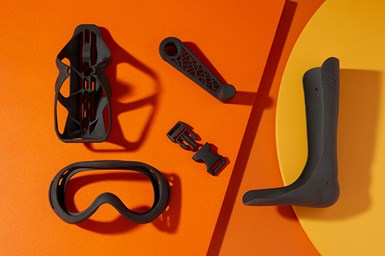Formlabs Develops Powder for Strong, Flexible End-Use Parts, Prototypes
The material’s characteristics enable users to print end-use parts that need to bend or take impact such as hinges, clips and orthotics.

Nylon 11 Powder’s ductile, strong and flexible characteristics make it well suited for end-use parts that must be able to take impact and handle wear and tear over time, including snaps, clips, and hinges.
Formlabs’ Nylon 11 powder is a high-performance nylon material developed for functional prototyping and small batch production. It is designed for use on Formlabs’ Fuse 1 high-performance selective laser sintering (SLS) 3D printer.
The material enables users to print parts that need to bend or take impact such as hinges, clips and orthotics, making it well suited for manufacturing, engineering, and health care uses. Nylon 11 powder is one of many materials Formlabs plans to launch for use with the benchtop Fuse 1 printer, which is designed to make industrial 3D printing more cost accessible and user friendly with its straightforward workflow.
The Nylon 11 powder was developed to bolster design and creation capabilities with low cost per part. It requires less training and additional equipment needed, compared to other PA11 materials on the market, the company says. This is said to expand the functionality of the Fuse 1 and enable users to print end-use parts that can handle wear and tear over time, all in-house.
The material is said to be optimal for products requiring durability and performance. Nylon 11 Powder’s ductile, strong and flexible characteristics make it well suited for end-use parts that must be able to take impact and handle wear and tear over time, including snaps, clips, and hinges. It also designed for use in manufacturing, production, engineering and product design to create impact-resistant prototypes, thin-walled ducts and enclosures, robust jigs and fixtures, replacement parts, and prosthetics and orthotics.
According to the company, using Nylon 11 powder with the Fuse 1 gives engineers, product designers and manufacturers design freedom, the ability to customize end-use parts, and speed in bringing products to market.
Related Content
-
Copper, New Metal Printing Processes, Upgrades Based on Software and More from Formnext 2023: AM Radio #46
Formnext 2023 showed that additive manufacturing may be maturing, but it is certainly not stagnant. In this episode, we dive into observations around technology enhancements, new processes and materials, robots, sustainability and more trends from the show.
-
Possibilities From Electroplating 3D Printed Plastic Parts
Adding layers of nickel or copper to 3D printed polymer can impart desired properties such as electrical conductivity, EMI shielding, abrasion resistance and improved strength — approaching and even exceeding 3D printed metal, according to RePliForm.
-
Understanding PEKK and PEEK for 3D Printing: The Cool Parts Show Bonus
Both materials offer properties desirable for medical implants, among other applications. In this bonus episode, hear more from Oxford Performance Materials and Curiteva about how these companies are applying PEKK and PEEK, respectively.









.jpg;maxWidth=300;quality=90)



